Earn Their Trust: Personalizing Customer Outreach the Right Way
Published on November 19, 2015/Last edited on November 19, 2015/9 min read


Todd Grennan
Content Production Principal, Content Marketing at BrazeIt’s happening more and more. When brands message their audience, that outreach is individually customized for the person receiving it. That can be really appealing (Why, yes, I WOULD like to buy that monogrammed sweater!) and it can be a little unsettling (Um, how does my foreign language app know that I moved across town?)
As a marketer, you’re on both sides of this. You’ve likely already received a few eyebrow-raising personalized messages, but you’re also probably considering how to take advantage of them yourself—if you haven’t already. So let’s take this opportunity to dig a little deeper into personalization and how to use it in your outreach in appealing (and non-creepy) ways.
Why personalize?
Because personalization gets results. Brands that personalize messages sent to their customers see a 27% increase in conversions compared to those that don’t. That’s a big difference. Plus, many of today’s customers have come to crave personalization: 79% of U.S. shoppers expect personalized experiences from the brands they buy from.
What makes personalization possible?
Personalization is built on smart, effective customer data collection. The information you collect on customers and their activity on mobile, desktop, and beyond determines both how well you understand each member of your audience, but also what sorts of personalization are possible. After all, you can’t add a customer’s name to an email if you don’t know what their name is…
Why is some personalization appealing and some creepy?
Mobile is intimate: people carry smartphones with them everywhere, sleep with their devices within reach (71% of people!), even experience an arriving message as a vibration against their leg. And personalization can make mobile messaging feel more intimate still by drawing in personally relevant information about each recipient. That can make the messaging more powerful, but it can also make your outreach feel creepy or invasive when personal data isn’t used thoughtfully.
There’s a precedent for this kind of intimacy. Back in the day, before mobile, before the Internet–maybe before you were born–shopkeepers used to be on a first-name basis with many of the customers who bought things from them. People would come in regularly for years, allowing merchants to learn their preferences and become a trusted advisor, rather than just someone peddling a product. But that kind of relationship depended on the thoughtfulness and discretion of each shopkeeper. And the same principle applies today.
Everyone likes to feel understood, but we all have boundaries, too. Personalization is going to be the most effective when it makes customers feel understood by your brand without overstepping their personal boundaries.
What can you personalize (and how should you do it)?
Names
By pulling customer names from your audience profiles and adding them to emails, push notifications, or in-app messages, you can demonstrate to the recipients of your outreach that you know who they are and that they’re real people to you, not just faceless, nameless users.
Imagine that your brand has an app called CalorieRocket that lets customers have food delivered from local restaurants. When you want to let your audience know about a new promotion you’re running, using each customer’s name in the message makes your outreach feel like a personal heads-up about a good deal, instead of just another generic sales pitch. It’s also pretty easy to do.
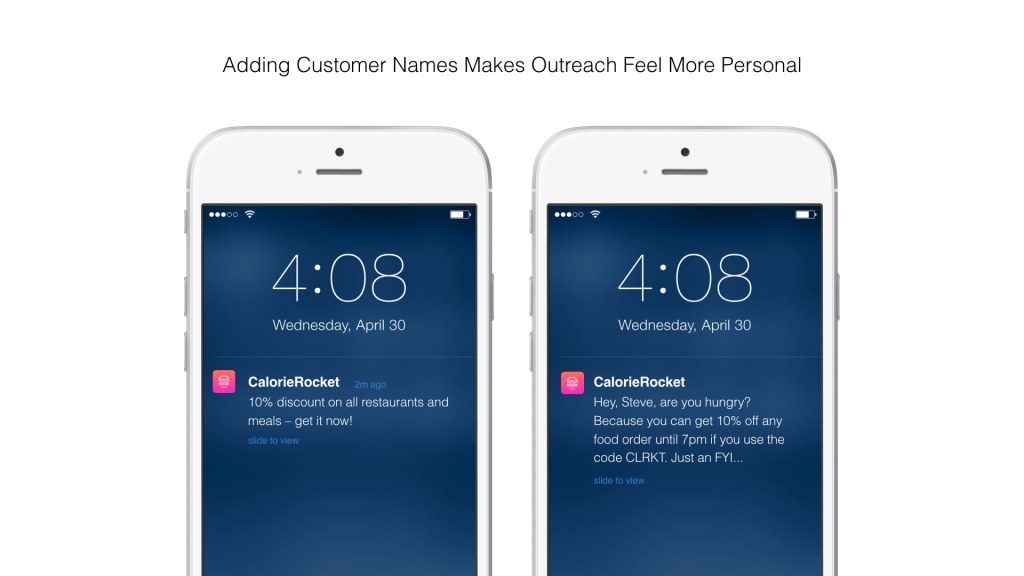
Don’t be a creep: Be careful if you’re messaging people who haven’t voluntarily provided you with their name, whether by logging into your app, registering for your website, or making an in-person purchase. You want customers to focus on your outreach’s call to action, not worry about how you got their name.
Events and Attributes
Compelling messages provide customers with something that’s relevant to their interests and valuable to them as individuals. By personalizing your messages based on customer attributes–like age, gender, or favorite color–and events, like whether they’ve made a purchase or abandoned a shopping cart, you can take into account what you know about each customer as a person and how they’ve engaged with your brand to make your outreach more useful and relevant to the people receiving it.
Imagine that CalorieRocket has just added a new feature that automatically adjusts what dishes are displayed on the app based on the dietary restrictions customers include in their profiles. If you’ve been tracking when customers list themselves as vegetarian, gluten-free, etc., you can personalize based on those customer attributes in the message you send announcing the new feature, showing that you’re taking their individual needs into account when improving the app.
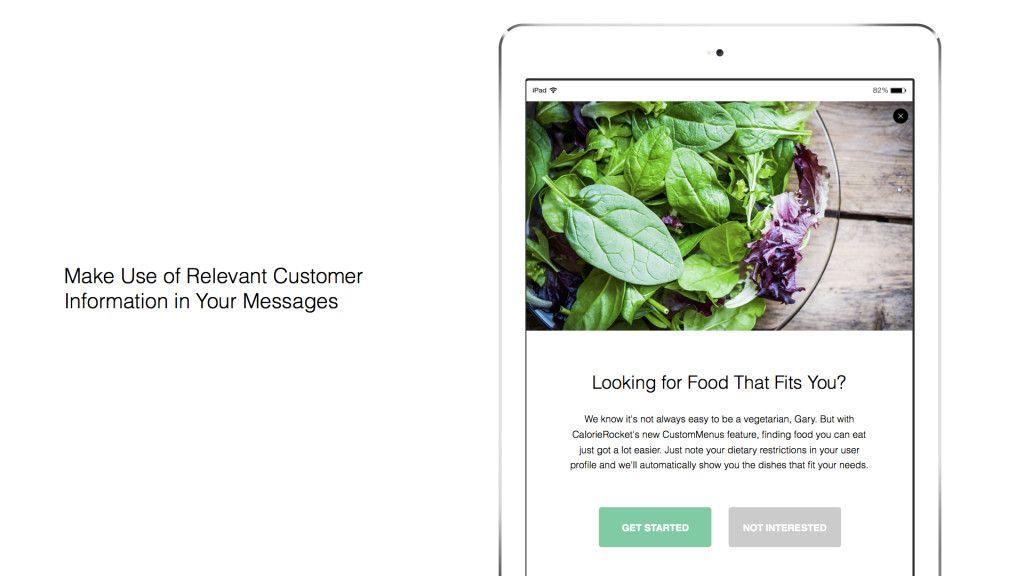
Don’t be a creep: Customers want to feel understood, not watched. Adding customer data to your messages that doesn’t bolster the relevance or value of that message isn’t accomplishing anything. And if the information is irrelevant or too personal, you might actively alienate customers. Before you personalize based on customer events or attributes, make sure the information you’re including adds value to outreach.
Location
Personalizing your campaigns based on each customer’s location makes it possible to craft outreach that’s specific to recipients in individual countries, cities, or even neighborhoods. That makes it easy to build intimacy and demonstrate usefulness by ensuring that customers receive messages that are relevant to where they actually live, work, and shop.
If CalorieRocket is announcing a nationwide promotion to mark National Donut Day, you can use location-based personalization to send one version of a message to recipients in the New York City area, a second version to people in Los Angeles, and a more general default version to individuals who don’t live in either city. That way you can highlight appealing local donut shops to people in New York City and Los Angeles without teasing the rest of the country with delicious-sounding donuts they can’t have.
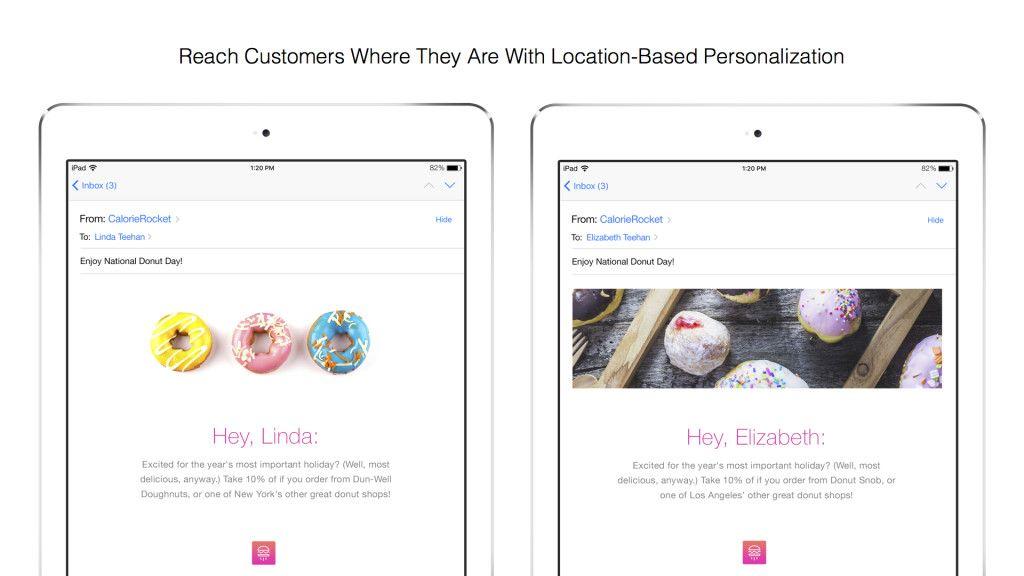
Don’t be a creep: Few customers are going to be creeped out if they receive a message promoting donut shops near them. But 74% of people would find it creepy if their location was tracked to allow them to be greeted by name when they enter a store. There’s a lot of space between those two extremes and different customers will react differently to location-based personalization. Be thoughtful about how the campaigns you send will make customers feel and make sure that you’re using location information in ways that add value for message recipients.
Language
Language-based personalization lets you send a single campaign that adjusts to match the preferred language of each recipient, which sure beats creating 15 or more campaigns for every message, or worse, sending messages in a language your customers don’t speak or prefer. That’s a big deal—especially when you consider that 55% of people will only make a purchase if the message they receive about it is in their native language.
Imagine that CalorieRocket is active in both Spain and the United Kingdom. Normally, if you wanted to let your customers in both countries know about the app’s new one-touch ordering system, you’d need to send one campaign in English for customers in the United Kingdom, as well as three additional campaigns for your Castilian, Catalan and Basque-speaking Spanish customers. But if you personalize your outreach based on language, you can send one campaign that automatically adjusts based on each recipient’s language—so you don’t have to worry that someone in Barcelona just received a push notification they can’t understand.
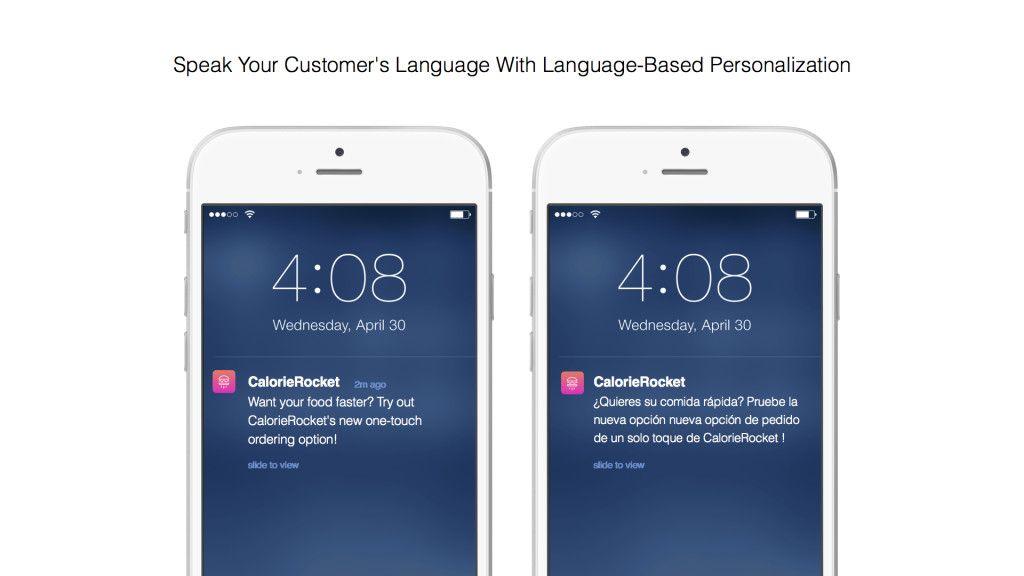
Don’t be a creep: Be careful about sending messages in languages you don’t speak. It’s easy to accidentally use words or make references that customers will find unsettling or offensive if you’re not familiar with a recipient’s language or culture.
Dynamic Content
By using dynamic content to individually customize messages with information from third-party sources, like public APIs, or your own servers, you can send campaigns that incorporate real-time information, such as weather updates or movie listings. That lets you use your brand’s complete knowledge of your customers—including information that may not be contained in their profiles—to make the messages you send more relevant and useful to the people receiving them.
Imagine that CalorieRocket sends emails to reach customers who haven’t made an order in the last two weeks. By personalizing with dynamic content, you can add individualized food suggestions from CalorieRocket’s in-house recommendation engine, making the re-engagement messages individually relevant and valuable.
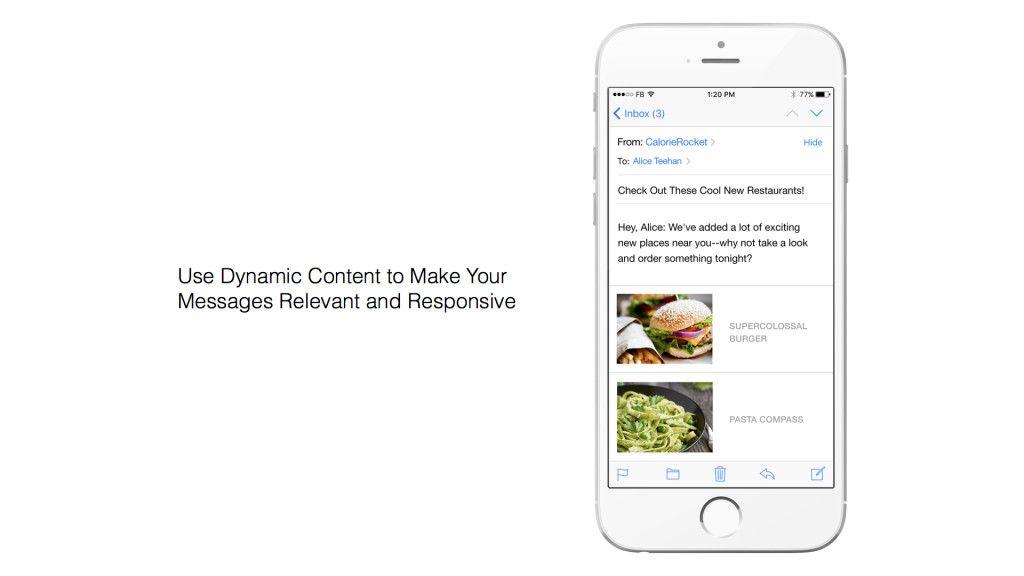
Don’t be a creep: If you’re using information that customers have agreed to share (preferred foods, favorite restaurants, etc.) to power your use of personalized dynamic content, it shouldn’t raise any eyebrows. But some customers may find your outreach invasive if the dynamic content you include is based on something they didn’t realize you had access to, so be thoughtful when using this kind of personalization.
Delivery Time
This one’s a little different. Delivery time personalization uses data about each recipient’s engagement with previous outreach to ensure that every customer receives your message at the time when they’re most likely to engage.
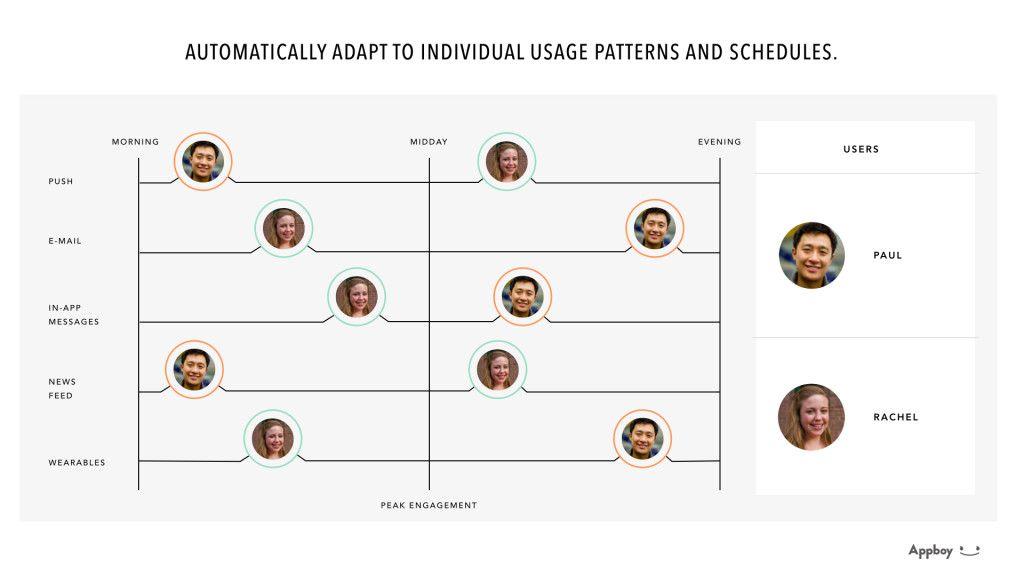
Imagine that CalorieRocket is announcing a special deal giving all customers 25% off their next order if they make it within 24 hours. By using delivery time personalization, each one of your customer’s will get the message at the time that’s most likely to work for them. That could be at 8:00 a.m., during their morning commute, or at 8:00 p.m., when they’re at a bar with friends. By individually customizing each recipient’s delivery time, your message feels less intrusive and your customers will be more likely to engage, leading to better results for the campaign.
Don’t be a creep: The odds that this sort of personalization will strike customers as creepy or unsettling is pretty much nil. So as long as you’re being thoughtful about the content of the messages you send, you’re good to go.
The gist
You’re gathering all this information on your audience—you should use it. But if you personalize in ways that don’t add value for your customers or are likely to overstep personal boundaries, you’re shooting yourself in the foot. At its best, personalized messaging lets you act as each customer’s trusted advisor, giving them useful, individually relevant guidance that strengthens their relationship with your brand. That’s the goal.
Want to experiment to see what kinds of personalization resonate with your audience? Use multivariate testing first to see what kind of impact each message has (positively or negatively) on your customers. That way, you can be bold with your use of personalization without worrying that you’re creeping out your audience en masse.
Related Tags
Releated Content
View the Blog
The new inbox reality: How iOS changes are reshaping email marketing

Aparna Prasad

Experience optimization: Turning data insights into better journeys

Team Braze

December 2025 Bonfire Marketer of the Month: Jagex’s Emma Oliver
